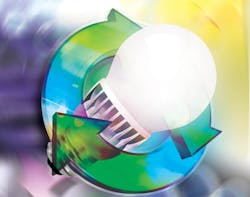EPA releases Draft 2 of the Energy Star Lamps specification V2.0
While a key goal of Lamps V2.0 was higher efficacy levels in LED retrofit lamps, the EPA has agreed to lower targets slightly to provide consumers with more choices in energy-saving lamps.
The US Environmental Protection Agency (EPA) has released the second draft of version 2.0 (V2.0) of the Energy Star Lamps specification. The EPA hopes to complete the V2.0 specification this June with the goal of the specification becoming effective in June 2016. Comments on Draft 2 are due to the EPA by May 9, 2015 and can be emailed to [email protected].
The Lamps V2.0 work began in earnest in October 2014 when the EPA held a Lamps-specific session at the annual Energy Star Partners meeting. The goal was a fast-track revision that would pursue higher efficacy levels and a broader scope of the specification in terms of the types of lamps that were covered.
In addition to the aforementioned goals, the EPA seeks to support the LED lamp testing methodology that is pending publication at the US Department of Energy (DOE). Moreover, the EPA said Draft 2 will improve harmonization between the various Energy Star lighting specifications.
Ironically, comments from Draft 1 of the specification convinced the EPA to back off slightly on its goals of raising efficacy requirements. Draft 1 had specified minimum efficacy of 70 lm/W for omnidirectional lamps and that figure has been reduced to 65 lm/W in Draft 2. Stakeholders from the lamps industry felt that the higher level would have essentially eliminated omnidirectional compact fluorescent lamp (CFL) products from the Energy Star program. Many stakeholders have designed CFL products to the prior efficacy levels and the EPA made the change that will allow those products to continue in the program.
Draft 2 has also lowered the efficacy requirement for decorative lamps that consume 7W or less from 65 lm/W to 55 lm/W. Lamps that operate above 7W must still meet the higher requirement. Stakeholders had argued that a lower efficacy level would enable far more decorative lamps to achieve Energy Star compliance and ultimately encourage broader adoption of energy-efficient lamps including LED-based products in the decorative application, thereby positively impacting energy conservation.
There are also a number of changes in Draft 2 focused on subtleties of lamps technology, especially focused on LED-based products. For example, color-tunable products must be tested for efficacy at the least-efficient white-light setting — basically a requirement that manufacturers test the lamps at the warmest CCT. The startup time for an LED lamp has been set at 750 msec, or at 1 sec for wireless-network-enabled lamps. Draft 2 has loosened the requirement that connected lamps should be capable of reporting intensity and color settings and instead such lamps will only be required to report on/off status.
There are also subtle changes relative to CFLs. For example, the EPA will not require that CFLs achieve a CRI R9 value above 0. But CFL manufacturers must still report an R9 value.
You can review the complete V2.0 specification at the EPA lamps website. The V2.0 effort is moving much more quickly than did the preceding revisions. The EPA only finalized V1.1 in September of 2014. That specification followed V1.0 published in August 2013.
The EPA will host a webcast on April 20, 2015 to provide a detailed review of the changes proposed for V2.0. You can register for the webcast at the Lamps website linked above.

Maury Wright | Editor in Chief
Maury Wright is an electronics engineer turned technology journalist, who has focused specifically on the LED & Lighting industry for the past decade. Wright first wrote for LEDs Magazine as a contractor in 2010, and took over as Editor-in-Chief in 2012. He has broad experience in technology areas ranging from microprocessors to digital media to wireless networks that he gained over 30 years in the trade press. Wright has experience running global editorial operations, such as during his tenure as worldwide editorial director of EDN Magazine, and has been instrumental in launching publication websites going back to the earliest days of the Internet. Wright has won numerous industry awards, including multiple ASBPE national awards for B2B journalism excellence, and has received finalist recognition for LEDs Magazine in the FOLIO Eddie Awards. He received a BS in electrical engineering from Auburn University.





